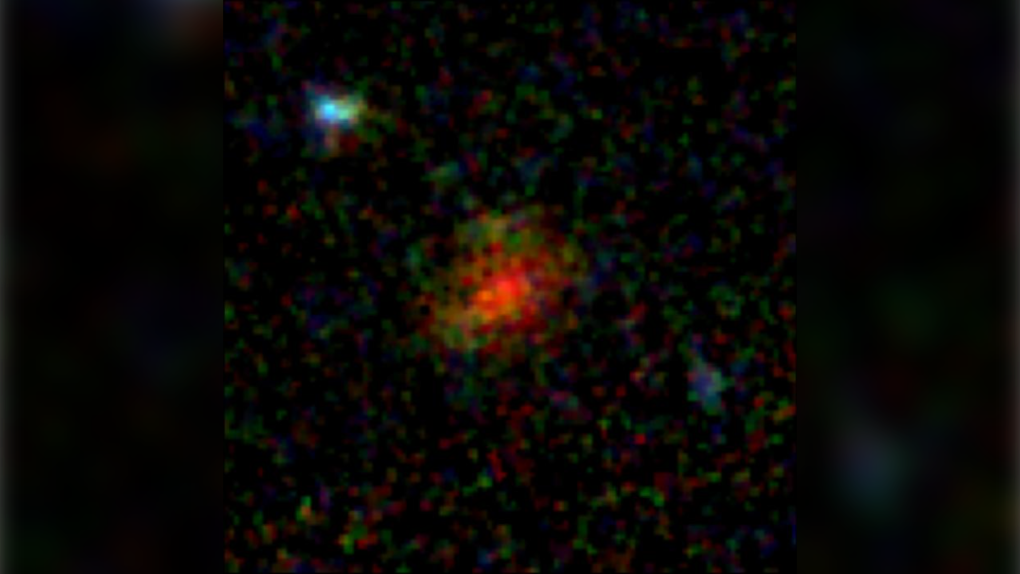New observations from the James Webb Space Telescope have found something that could change the way we think about the universe: a lost galaxy.
More than a decade ago, a ground-based telescope picked up a distant, fuzzy blob that astronomers thought might be a galaxy, only for all trace of it to vanish when the Hubble Space Telescope, a much more powerful instrument, looked in its direction.
The mystery of this Schroedinger’s galaxy and how far away from us it might be has persisted until now, when observations from James Webb Telescope confirmed the presence of a massive, dusty, star-forming galaxy situated deep in space.
“This thing is a real monster,” Jed McKinney, a postdoctoral researcher at The University of Texas at Austin and lead author of the research, said in a press release. “Even though it looks like a little blob, it’s actually forming hundreds of new stars every year. And the fact that even something that extreme is barely visible in the most sensitive imaging from our newest telescope is so exciting to me. It’s potentially telling us there’s a whole population of galaxies that have been hiding from us.”
The galaxy, which has been named AzTECC71, is being viewed at around 900 million years after the Big Bang. Its discovery and properties are described in a paper published in The Astrophysical Journal in October.
The discovery was made by astronomers working with the COSMOS-Web collaboration, a project that is mapping a continuous region of space using as many types of imaging as possible to create a detailed picture of up to a million galaxies stretching back in time and space away from us.
COSMOS-Web was one of the first projects given observation time with James Webb, and is currently working through the data of more than 250 observing hours, with more data set to come through in January 2024.
According to astronomers, AzTECC71 is exciting because it suggests that the early universe may have been full of much more stellar dust than we knew about before.
AzTECC71’s star formation rate is around eight times higher than other galaxies like it, researchers found, and other galaxies like it may be three to 10 times more common than expected.
If large dust reservoirs like AzTECC71 are that common in the early universe, it could have “profound implication on early galaxy formation,” the research states.
So why couldn’t Hubble see this galaxy?
It has to do with the type of imaging that Hubble and James Webb are capable of. Hubble uses a mirror-based optical system to gather and focus light from across the universe into images that scientists can examine.
However, this doesn’t work as well to detect galaxies that are shrouded in clouds of dust, since these obscure the light from stars and re-emit that light at longer wavelengths that are harder to pick up with an optical system.
“Until now, the only way we’ve been able to see galaxies in the early universe is from an optical perspective with Hubble,” McKinney said. “That means our understanding of the history of galaxy evolution is biased because we’re only seeing the unobscured, less dusty galaxies.”
AzTECC71 had been spotted a couple times before, first as a blob by the James Clerk Maxwell Telescope in 2011-12, which looks for wavelengths between far infrared and microwave. It was next picked up by the COSMOS-Web team using the ALMA telescope in Chile, which can also see in infrared and has higher spatial resolution. But it wasn’t until COSMOS-Web were able to cross-reference with the James Webb data that they were able to confirm the galaxy’s existence.
Now, astronomers are hoping that they will be able to both confirm and find more “Hubble-dark galaxies” which were in question before or were completely invisible.
“With JWST, we can study for the first time the optical and infrared properties of this heavily dust-obscured, hidden population of galaxies,” McKinney said, “because it’s so sensitive that not only can it stare back into the farthest reaches of the universe, but it can also pierce the thickest of dusty veils.”




